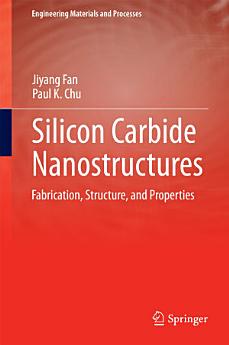Silicon Carbide Nanostructures: Fabrication, Structure, and Properties
Acerca de este libro electrónico
SiC nanostructures exhibit a range of fascinating and industrially important properties, such as diverse polytypes, stability of interband and defect-related green to blue luminescence, inertness to chemical surroundings, and good biocompatibility. These properties have generated an increasing interest in the materials, which have great potential in a variety of applications across the fields of nanoelectronics, optoelectronics, electron field emission, sensing, quantum information, energy conversion and storage, biomedical engineering, and medicine. SiC is also a most promising substitute for silicon in high power, high temperature, and high frequency microelectronic devices. Recent breakthrough pertaining to the synthesis of ultra-high quality SiC single-crystals will bring the materials closer to real applications.
Silicon Carbide Nanostructures: Fabrication, Structure, and Properties provides a unique reference book for researchers and graduate students in this emerging field. It is intended for materials scientists, physicists, chemists, and engineers in microelectronics, optoelectronics, and biomedical engineering.
Acerca del autor
Jiyang Fan is a Professor of Physics at Southeast University. He received his MS in theoretical physics from the Institute of Theoretical Physics in Chinese Academy of Sciences and PhD in condensed matter physics from Nanjing University. He has conducted research on silicon carbide nanostructures for a number of years including his doctorate work. He is currently conducting work on semiconductor nanomaterials, focusing on their electronic and optical properties. His other interests include carbon nanomaterials and applications of nanocrystals in biotechnology.
Paul K Chu is a Chair Professor of Materials Engineering at City University of Hong Kong. He received his BS in mathematics from The Ohio State University in mathematics in 1977 and PhD in chemistry from Cornell University in 1982. He is a fellow of the American Physical Society, IEEE (Institute of Electrical and Electronic Engineering), American Vacuum Society, and Materials Research Society. He is chairman of the International Plasma-Based Ion Implantation Executive Committee and a member of the Ion Implantation Technology (IIT) International Committee as well as the IEEE Nuclear and Plasma Science Society Fellow Evaluation Committee. He is associate editor of Materials Science and Engineering: Reports, and a member of the editorial board of Biomaterials, Advanced Materials Interfaces, Surface and Coatings Technology, etc. He is editor of 8 books on plasma science and engineering, biomaterials, and nanotechnology and co-authored more than 30 book chapters. He has authored / co-authored more than 1,100 journal papers. He is internationally known in the area of surface modification and processing of a myriad of materials including nanostructured SiC




